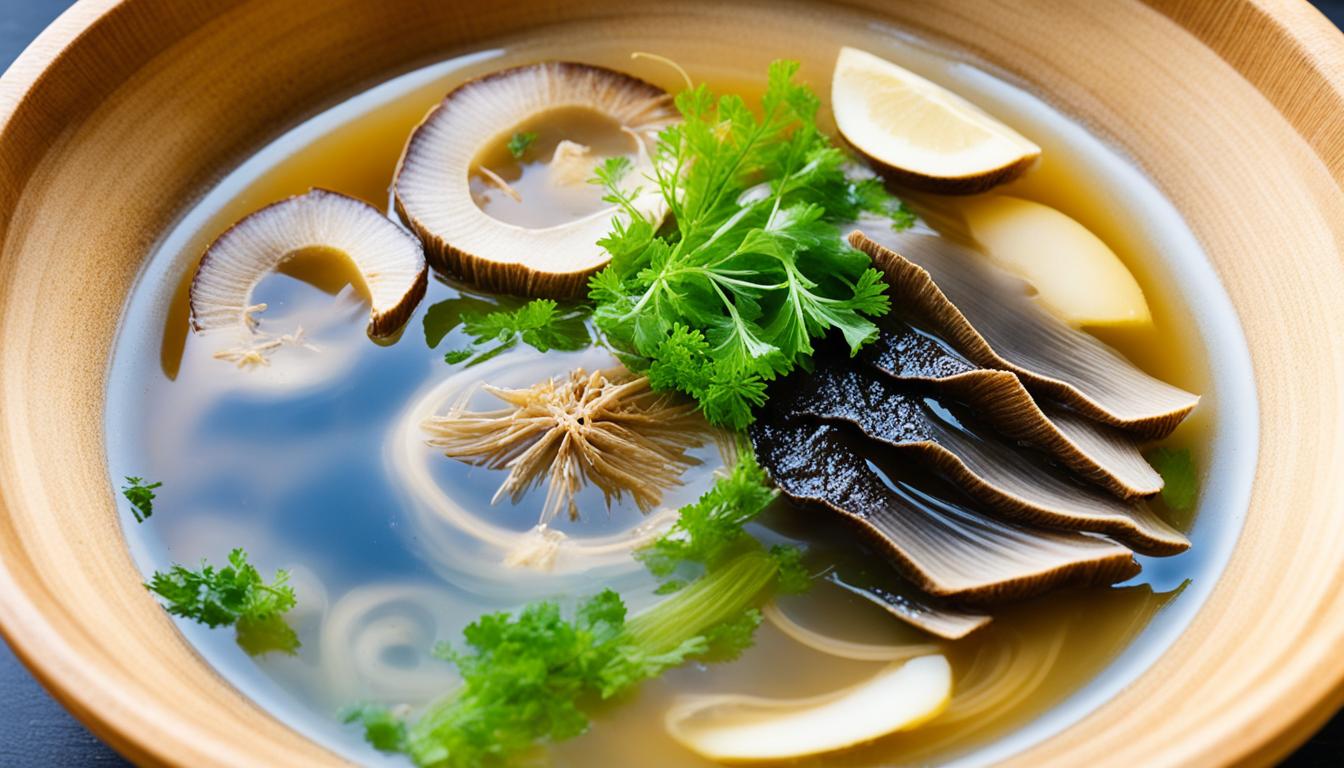Have you ever wondered what gives traditional Japanese dishes their unique and irresistible umami flavor? The secret lies in a key ingredient known as dashi – a flavorful Japanese stock that forms the foundation of umami-rich broths. From miso soup to noodle dishes, dashi is a staple in Japanese cuisine, adding depth and complexity to a wide variety of dishes.
But what exactly is dashi and how can you make it at home? In this article, we’ll explore the world of dashi, its umami-rich taste, its versatility in Japanese and non-Japanese cuisine, and provide you with an authentic dashi recipe to try in your own kitchen.
The Key to Dashi’s Taste: Umami
Dashi, the traditional Japanese stock, is renowned for its unique and delicious flavor profile. At the heart of this flavor is umami, often referred to as the fifth taste alongside sweet, sour, salty, and bitter. Umami is a savory and rich flavor that is created by the presence of glutamates and inosinates in food.
In dashi, umami is derived from the umami-rich ingredients used in its preparation. Kombu, the dried kelp, is a primary source of umami in dashi. Additionally, katsuobushi, dried bonito flakes, dried shiitake mushrooms, and niboshi, dried sardines, also contribute to the umami taste. These ingredients contain high levels of glutamates and inosinates, which intensify the umami flavor in dashi.
Umami not only adds depth and complexity to the overall taste of dashi, but it also has a synergistic effect when combined with other ingredients. When umami-rich dashi is incorporated into dishes, it enhances the flavors of other ingredients, resulting in a more satisfying and delicious taste experience. The umami taste in dashi is a fundamental aspect of Japanese cuisine, giving it its essential umami flavor that is beloved by food enthusiasts worldwide.
To visually enhance the concept of umami in dashi, take a look at this image:
Umami in dashi brings a unique and delightful taste to various Japanese dishes, making it an indispensable ingredient in the culinary world.
The Versatility of Dashi
Dashi, the traditional Japanese stock, offers incredible versatility in culinary applications. This umami-rich stock serves as the foundation for various Japanese dishes, such as miso soup, noodle soups, simmered dishes, and rice bowls, where it adds depth and enhances the overall flavor profile.
However, dashi’s versatility goes beyond Japanese cuisine. It is a secret ingredient that can elevate the taste of dishes in non-Japanese culinary traditions as well.
In Western cuisine, dashi can be used as a liquid flavor enhancer, enriching dishes like creamy polenta or creating a delicate fish fumet. Its umami notes bring complexity and depth to these dishes, creating an elevated flavor experience.
In addition, dashi finds its place as a soup base in other Asian cuisines. From Korean soups to Chinese hot pots, dashi infuses robust umami flavor into these diverse culinary traditions.
This adaptability stems from the richness of umami found in dashi, which enhances the taste of a wide variety of ingredients and adds a savory complexity to meals.
Dashi’s Uses in Culinary Delights:
- Base for miso soup
- Essential element in noodle soups
- Flavor enhancer in simmered dishes
- Secret ingredient in rice bowls
- Ingredient for creamy polenta
- Foundation for fish fumet
- Soup base in Korean and Chinese cuisines
Dashi’s inherent umami richness allows it to effortlessly enhance the taste of these dishes and adds a touch of Japanese culinary artistry to global cuisine.
Making Dashi at Home
Making dashi at home is easier than you might think. The basic recipe for dashi involves soaking kombu in water and then adding katsuobushi to create the stock. However, there are different variations and methods for making dashi, depending on the desired flavor and intensity.
Key ingredients for making dashi include kombu, katsuobushi, dried shiitake mushrooms, and niboshi. These can be easily sourced from Asian grocery stores or online. Soaking kombu in water for a period of time helps to extract its umami flavor. Adding katsuobushi and other ingredients further enhances the umami taste.
There are also vegetarian-friendly options for dashi, using only kombu and dried shiitake mushrooms. Experimenting with different ratios and cooking times allows you to customize the flavor of your dashi to suit your preferences. Homemade dashi can be stored in the refrigerator for up to a week or frozen for longer use. Enjoy the authentic taste of dashi by making it at home and exploring the world of Japanese cuisine.
